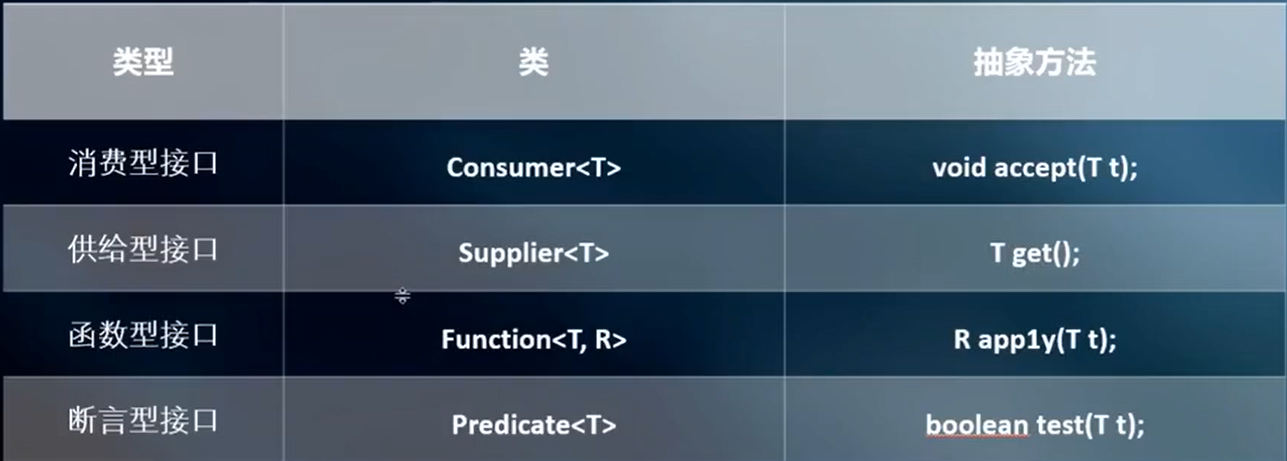package work.artorias.test.lambda;import java.util.Comparator;import java.util.function.Consumer;import java.util.function.Function;import java.util.function.Predicate;import java.util.function.Supplier;/** * 拉姆达表达式基础学习 * @author LJ */public class LambdaBase { /** * 总结: 拉姆达表达式就是作为方法入参的一种简单书写形式,当一个方法入参是一个接口,并且该接口只有一个方法未实现,这种接口叫做函数式接口 * ,就可以使用lambda表达式 * lambda表达式的作用就是匿名实现了这个接口作为入参 * * 为了方便我们使用JDK提供了许多函数式接口,其中有4中核心接口。以提供更方便的编程 * */ /** * * @param args */ public static void main(String[] args) { System.out.println("1:"); new LambdaBase().lambdaRule1(); System.out.println("--------------------------------"); System.out.println("2:"); new LambdaBase().lambdaRule2(); System.out.println("--------------------------------"); System.out.println("3:"); new LambdaBase().lambdaRule3(); System.out.println("--------------------------------"); System.out.println("4:"); new LambdaBase().lambdaRule4(); System.out.println("--------------------------------"); System.out.println("5:"); new LambdaBase().lambdaRule5(); System.out.println("--------------------------------"); } /** * 无参无返回值 * 方法体只有一行可以省略{} */ public void lambdaRule1(){ LambdaTest1 lambdaTest1=()-> System.out.println("无参无返回值方法"); lambdaTest1.a(); } /** * 一个参数无返回值 * 参数只有一个可以省略() * * Consumer<T> 接口是JDK提供用于使用lambda的接口,他是一个函数式接口,其中只有一个未实现方法。该接口也可以叫做消费者 * void accept(T t); * 泛型标明了入参类型 */ public void lambdaRule2(){ Consumer<String> stringConsumer=x->System.out.println(x); stringConsumer.accept("一个参数无返回值"); } /** * 有多个参数,有返回值 * Comparator<T>这是JDK自带的比较器接口,实现该接口的类需要实现一个方法以实现实例的比较,泛型T标明实例类型, * int compare(T o1, T o2); * * 这种就是通用写法,如果只有一条语句return也可以省略 */ public void lambdaRule3(){ Comparator<Integer>integerComparator=(Integer x,Integer y)->{ System.out.println("x="+x+" "+"y="+y); return Integer.compare(x,y); }; int compare = integerComparator.compare(4, 5); System.out.println(compare); } /** 上面的补充,入参类型是可以省略的 */ public void lambdaRule4(){ Comparator<Integer>integerComparator=(x, y)->{ System.out.println("x="+x+" "+"y="+y); return Integer.compare(x,y); }; int compare = integerComparator.compare(4, 5); System.out.println(compare); } /** * lambda中::的使用 * * 基本就是如果有某个实现类的方法和你需要写的lambda一样,就可以直接使用 * 就像类名可以直接调用静态方法一样,这里也可以 * */ public void lambdaRule5(){ Consumer<String>stringConsumer=System.out::println; stringConsumer.accept("::的使用"); } /** * jdk提供的四大函数式接口 */ public void functionInterfance(){ /** *消费型接口 * Consumer<T> * void accept(T t) */ Consumer<String>stringConsumer=x-> System.out.println(x); /** *供给型接口 * Supplier<T> * T get() */ Supplier<String>stringSupplier=()->"供给型接口"; /** *函数式接口 * Function<T, R> * R apply(T t) */ Function<String,Integer>stringIntegerFunction=x->Integer.parseInt(x); /** *断言式接口 * Predicate<T> * boolean test(T t) */ Predicate<Integer>integerPredicate=x->x.equals(0)?true:false; } interface LambdaTest1{ void a(); }}



